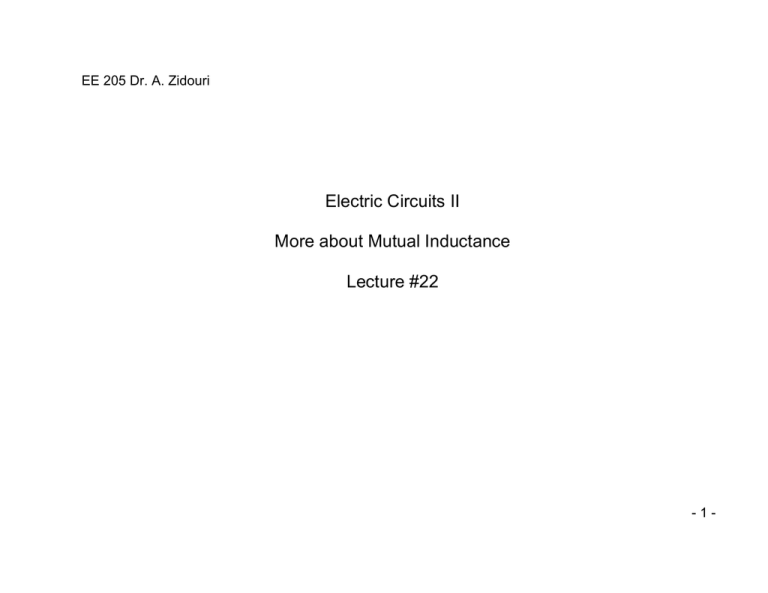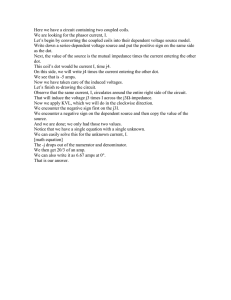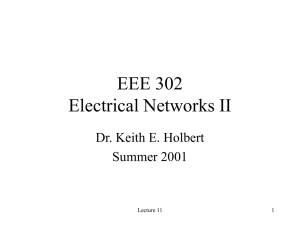Electric Circuits II More about Mutual Inductance Lecture #22
advertisement

EE 205 Dr. A. Zidouri Electric Circuits II More about Mutual Inductance Lecture #22 -1- EE 205 Dr. A. Zidouri The material to be covered in this lecture is as follows: o o o o Mutual Inductance in Terms of Self Inductance Mesh Current Analysis of magnetically coupled Circuits Procedure for Determining Dot Markings Energy Calculation After finishing this lecture you should be able to: ¾ ¾ ¾ ¾ Analyze Circuits with Mutual Inductance Determine the Coefficient of Coupling Determine the Dot Markings of neighboring Coils Perform Energy Calculations in Magnetically Coupled Circuits -2- EE 205 Dr. A. Zidouri Mutual Inductance in Terms of Self Inductance We have seen that L1 = N12p1 L2 = N22p2 L1L 2 Therefore But for linear system, = N12N22p1p 2 = N12N22 (p11p 21 )(p 22p12 ) p21 = p12 ⇒ ⎛ p ⎞⎛ p ⎞ L1L 2 = N12N22p12 ⎜ 1+ 11 ⎟⎜ 1+ 22 ⎟ ⎝ p12 ⎠⎝ p12 ⎠ ⎛ p ⎞⎛ p ⎞ = M2 ⎜ 1+ 11 ⎟⎜ 1+ 22 ⎟ ⎝ p12 ⎠⎝ p12 ⎠ ⎛ p11 ⎞⎛ p22 ⎞ 1 1+ 1+ ⎜ ⎟⎜ ⎟ Replacing the positive quantity by 2 gives a more meaningful expression k ⎝ p12 ⎠⎝ p12 ⎠ M2 = k 2L1L 2 or M = k L1L 2 -3- EE 205 Dr. A. Zidouri k is called the Coefficient of Coupling and must lie between 0 and 1: 0 ≤k ≤1 When Φ12 = Φ12 = 0 ⇒ p12 = 0 1 ⇒ 2 = ∞,or k = 0 k If no flux linkage between the coils, obviously which presents the Ideal State. M = 0 and k = 1, when Φ11 = Φ22 = 0 , -4- EE 205 Dr. A. Zidouri Mesh Current Analysis • To solve the following example 32-1, Let us reproduce the Mesh Current Equations that describe the following Circuit seen in Lec31: − + di di L dt dt + − M + L2 − di2 di M 1 dt dt − + di1 di − M 2 = 0 (Mesh 1) dt dt di di R2i2 + L2 2 − M 1 = 0 (Mesh 2) dt dt −vg + R1i1 + L1 -5- EE 205 Dr. A. Zidouri Example 32-1 ¾ Write a Set of Mesh-Current Equations that describe the Circuit in the following Figure: ¾ What is the Coefficient of Coupling of the Magnetically Coupled Coils? d (i1 + i3 ) di − 4.5 2 = 0 dt dt d (i + i ) di 6(i2 + i3 ) + 8(i2 − i1 ) + 4 2 − 4.5 2 3 = 0 dt dt −vg + 8(i1 − i2 ) + 9 − 4.5 − di2 dt + d (i1 + i2 ) dt + 20 i3 + 6( i2 + i3 ) + 4 4.5 k= d ( i1 + i3 ) di2 di +9 − 4.5 2 = 0 dt dt dt (Mesh 1) (Mesh 2) (Mesh 3) M 4.5 4.5 = = = 0.75 6 L1L 2 4×9 -6- EE 205 Dr. A. Zidouri Procedure for Determining Dot Markings The following six steps applied to the following figure determine a set of Dot Markings. 1) Arbitrarily Select one Terminal, (Say Terminal D) of one coil and mark it with a Dot 2) Assign a current into the dotted terminal and label it iD 3) Use the Right–Hand rule to determine the direction of the magnetic field established by iD inside the coupled coils and label this as ΦD 4) Arbitrarily pick one terminal of the second coil (Say Terminal A) and Assign a current into it (Show this as iA) 5) Use the Right–Hand rule to determine the direction of the magnetic field established by iD inside the coupled coils and label this as ΦA 6) Compare the directions of the two fluxes ΦD and ΦA. If the fluxes have the same reference direction, place a Dot on the terminal of the second coil where the test current (iA) enters. A (Step 6) C (Step 5) ΦA (Step 4) ΦD B (Step 3) (Step 2) D Arbitrarily Dotted Terminal (Step 1) Fig.32-2 Set of Coils Showing Steps for Determining a Set of Dot Markings In this example the fluxes ΦD and ΦA have the same reference direction, therefore a Dot goes on terminal A. -7- EE 205 Dr. A. Zidouri Example 32-2 ¾ The polarity markings on two coils are to be determined experimentally. The experimental setup is shown in Fig.32-3. When the switch is opened, the dc Voltmeter kicks upscale. According to the polarity and dot marking shown, where should we place the other dot? Answer: 9 The lower terminal of the unmarked coil has the same instantaneous polarity as the dotted terminal. 9 Therefore, place a dot on the lower terminal of the unmarked coil. -8- EE 205 Dr. A. Zidouri Energy Calculations For linear magnetic coupling 1 M12 = M21 2 M = k L1L 2 Consider the following Circuit Case 1: Increase i1 from 0 to I1, hold i1 = I1 and i2 = 0 ∫ w1 0 I1 dw = L1 ∫ di1 W1 = 0 1 2 L1I1 2 Case 2: Now we hold i1 = I1 and Increase i2 from 0 to I2 p = I1M12 di 2 + i 2v 2 dt -9- EE 205 Dr. A. Zidouri Energy Calculations (cont) The total energy stored in the pair of coils when i2 = I2 ∫ w w1 I2 I2 0 0 dw = ∫ I1M12 di 2 + ∫ L2 i 2 di 2 1 2 L2 I2 + M12 I1I2 2 1 1 W = L1I12 + L2 I22 + M12 I1I2 2 2 W = W1 + If we reverse the procedure – That is, if we first increase i2 from zero to I2 and increase i1 from zero to I1- The total energy stored is: W= 1 2 1 2 L1I1 + L2 I2 + M21I1I2 2 2 At any instant of time, the total energy stored in the coupled coils is: w(t) = 1 2 1 2 L1i1 + L2 i 2 + Mi1i 2 Assuming that both coil currents entered polarity marked terminals 2 2 In general: w(t) = 1 2 1 2 L1i1 + L2 i 2 ± Mi1i 2 2 2 - 10 - EE 205 Dr. A. Zidouri Example 32-3 Consider the circuit in Fig.32-5. Determine the coupling coefficient. Calculate the energy stored in the o coupled inductors at time t = 1s if v = 60 cos 4t + 30 V . ( ) 1 F 16 Solution: The coupling coefficient is k= M 2.5 = = 0.56 L1L 2 20 ¾ Means that the inductors are tightly coupled. ¾ To find the energy stored, we need to obtain the frequency domain equivalent of the circuit ( ) 60 cos 4t + 30o V ⇒ 60∠30o , ω = 4 rad 5H ⇒ j ω L1 = j 20Ω 2.5H ⇒ j ω M = j 10Ω 4H ⇒ j ω L 2 = j 16Ω 1 1 = − j 4Ω F⇒ 16 j ωC s The frequency domain equivalent is shown in Fig.32-6 below: - 11 - EE 205 Dr. A. Zidouri Solution (Cont): We now apply mesh analysis (10 + j 20) I1 + j10 I 2 = 60∠30o j10 I1 + ( j16 − j 4) I 2 = 0 Or I1 = −1.2 I 2 This yields I 2 ( −12 − j14) = 60∠30o ⇒ I 2 = 3.254∠160.6o A I1 = −1.2 I 2 = 3.905∠ − 19.4o A In the time domain ( ) = 3.254 cos ( 4t + 160.6 ) i1 = 3.905 cos 4t − 19.4o , i2 o At time t=1s, 4t= 4rad=229.2º, ( = 3.254 cos ( 229.2 ) i1 = 3.905 cos 229.2o − 19.4o = −3.389 A, i2 o ) + 160.6o = 2.824 A - 12 - EE 205 Dr. A. Zidouri Solution (Cont): The total energy stored in the coupled inductors is w= 1 2 1 2 L1i1 + L2i2 + Mi1i2 2 2 1 2 1 2 L1i1 + L2i2 + Mi1i2 2 2 1 1 = (5)( −3.389) 2 + (4)(2.824) 2 + 2.5( −3.389)(2.824) = 20.73 J 2 2 w= 60∠30o V - 13 - EE 205 Dr. A. Zidouri Self Test: When k equals zero, two inductors in series combine by a) addition b) subtraction c) product-over-sum d) multiplication answer: a Two parallel inductors with no mutual inductance combine by a) addition b) subtraction c) product-over-sum d) multiplication answer: c If N=200 and a rate of change of flux is 0.4 Wb/s. The voltage induced in the inductor is? a) 50 b) 80 c) 200 d) 500 answer: b Tow inductors are wound on a ferromagnetic core. The first Inductor has N1=200 and a rate of change of flux is 0.4 Wb/s. If the second Inductor has N2=125 turns and the coefficient of coupling is unity, how much voltage is induced in the second inductor? a) 50 b) 80 c) 200 d) 500 answer: a The self-inductances of the coils in Fig.32-4 are L1= 18 mH and L2 = 32 mH. If the coefficient of coupling is 0.85, calculate the energy stored in the system in millijoules when a) i1 = 6 A, i2 = 9 A; b) i1 = -6 A, i2 = -9 A; c) i1 = -6 A, i2 = 9 A; d) i1 = 6 A, i2 = -9 A. What conclusion do you draw? answer: a) 2721.60 mJ; b) 2721.60 mJ; c) 518.40 mJ; d) 518.40 mJ. Same answer when both current are entering or both leaving, and same answer when one is leaving and one is entering. - 14 -


